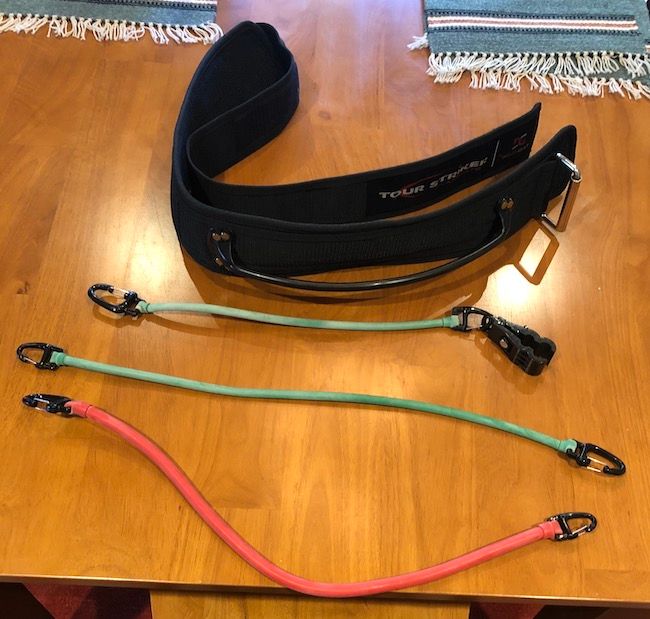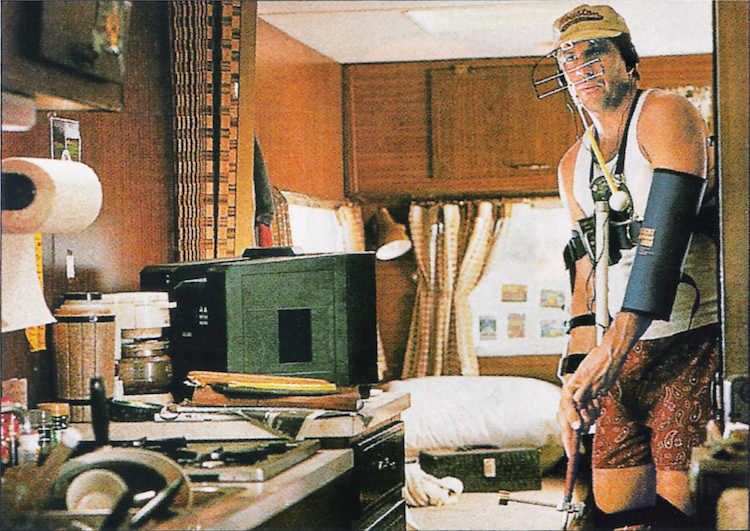
As I’ve grown older, I’ve become less focused on how my swing looks holistically and more focused on how it looks around impact—what Bobby Clampett called “the moment of truth.” Specifically, I’ve homed in on the concept of face stability—that is, the ability to deliver the clubface with the intended alignment at impact. I’ve been blessed/cursed in the fact that I’ve always had elite clubhead speed. Even today, at 40 years old, I average around 117 mph with the driver. At that speed, however, even a slight misalignment of the clubhead at impact can send my ball deep into the trees or even out of bounds. I’m convinced that learning to have more control of my club at the bottom of the swing is one of the keys for me to break through from being a middling state amateur to competing in national events.
For the past nine months, I’ve made significant improvements in my clubface stability using the Tour Striker PlaneMate. But like many swing aids, I have found success using it in a slightly different way than its makers intended. Let me explain.
The PlaneMate’s Primary Purpose
The PlaneMate is marketed as a tool to help you shallow the club on the downswing. Shallowing helps golfers keep the face stable through impact—to be honest, I’m not quite sure how, but it seems to be a generally accepted principle among swing instructors.
Here is a video from Andrew Rice explaining the concept further:
Why I’m the Perfect Pupil
I’ve always been quite steep on the downswing, so the PlaneMate seemed well-suited to help me improve my clubface stability. A former college teammate of mine recommended it to me last summer. I sat on the fence for a few weeks as it is not cheap (it sells online for just under $200). But I was hooked after I saw a video of Rory McIlroy practicing with it last winter.
.@McIlroyRory grinding with the plane mate @davidwoodspga 🔥 pic.twitter.com/11uJl0GBDO— The McIlroy Legion (@RoryLegion_GC) October 7, 2019
My ultimate goal when I bought the device was to learn how to “exit right”—the left-handed equivalent of leaving impact with low hands that rotate to the right around my body. Traditionally, I “throw” my clubs down the target line, which leads to a very “flippy” release.
If ever a device would help a golfer get the feel of shallowing out, the PlaneMate would be it. It consists of what is essentially a weight-lifting belt with a rail glued on to it. You attach your club to the rail using a stretchy cord (think resistance band or bungee cord).

How Does This Thing Actually Work?
When you get to the top of the swing, the tension in the stretchy cord pulls your hands down into a shallower position on the downswing. As you turn through impact, the device encourages you to “exit left” (for righties). If you throw your hands down the line you get tangled in the cord.

When you take the PlaneMate off, your muscles retain the feel of shallowing, thus (in theory) helping you continue the movement pattern without the device. The device comes with three different bungee cords—a short one for wedges, a longer one for mid-irons and woods, and a “heavy-resistance” band made for home or gym training without a ball. The teaching professionals behind the PlaneMate offer a free, online 7-day protocol to help familiarize new users with the device. The protocol requires the golfer to start with little chips and pitches and progress over the course of a week to full shots.
Here is a demo of how the PlaneMate is used from its inventor, Martin Chuck:
Fair Warning - You Will Look Like a Golf Tragic
The device is bulky and slightly ungainly. You will look a bit like what the Australians would call a “golf tragic” with it on (think Tin Cup in the scene after Costner develops the yips).

So if you’re an image-conscious golfer, you may want to work on the protocol at home with indoor golf balls so none of your friends can mock you on the range. Personally, I’m of a belief that golf is so hard there should never be any shame in experimenting with new ways to get better!
My Experience Following the Protocols
I followed the protocol to the letter and continued to practice with the PlaneMate for many, many hours after finishing it. But in the end, I found that I couldn’t get the “shallowing” movement pattern to stick.
As soon as I start adding speed to my practice regimen without the PlaneMate, I revert to a steeper downswing. Perhaps shallowing is just too foreign to someone who had swung differently for so long. I am tall with short arms, so perhaps my body just isn’t biomechanically suited to a “shallow swing.”
Perhaps I have physical limitations and inflexibilities that prevent me from shallowing— I have very limited internal shoulder rotation with my trail shoulder thanks to an old tennis injury, for instance. But whatever the reason, despite all the hours drilling with the device, my downswing is no shallower than it was when I started. So, despite all the hours invested in the PlaneMate, I’ve given up hope that it will help me learn to shallow.
Wait, There Is Good News!
I still feel the PlaneMate has done wonders for my game. The key has been the ingenious feature whereby you become tangled in the resistance cord if you get too flippy with the release. I learned that hitting dozens of wedge and half-shots with the PlaneMate without getting tangled up greatly improved my control at and around impact.
To be sure, I am not shallowing and “exiting right” like a left-handed Ben Hogan. But my “flippy” release has been muted and mellowed, as I explain in the below video (sorry for the wind noise!). And that’s made a huge difference to the consistency of my ball striking all the way through my bag.
Final Thoughts - Is the PlaneMate Worth It?
I’ve since recommended the PlaneMate to three friends who also have steep downswings and flippy releases. All three have gone through a similar journey. After using the device for many hours, they still can’t “shallow” once they add speed to their swing. They are all quite steep on the downswing. But nonetheless, they feel that the device has helped calm their overactive hands at impact, giving them more control and making their “big miss” less disastrous.
So I can heartily recommend the PlaneMate for golfers who struggle with clubface stability at impact—particularly golfers who get steep on the downswing and throw the club down the line after impact.
Unfortunately, I don’t think the PlaneMate will suddenly have you looking like Sergio Garcia on the downswing, nor Ben Hogan shortly after impact (Hogan was the king of “exiting left.”) But it may help you learn to be a bit more stable and less flippy through the hitting zone, and the result should be an immediate improvement to your score.
We care about the protection of your data Read our Privacy Policy